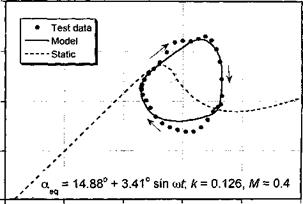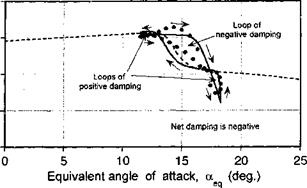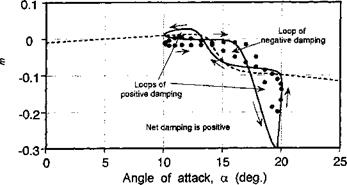Future Modeling Goals with Semi-Empirical Models
Overall, it can be seen from the results shown in Figs. 9.8 and 9.9 that the semi – empirical dynamic stall model provides fairly satisfactory predictions of the unsteady airloads, for both pitching and plunging oscillations. Again, these results can only be considered as representative, and other semi-empirical models may provide better (or worse) results. None of the current models, however, can be considered as the last word on the problem, and it is likely that improved semi-empirical models of dynamic stall will continue to be developed for use in helicopter rotor applications.
The need to use some empirically identified coefficients in the types of dynamic stall models used in helicopter analyses is unavoidable. Empiricism, however, is not a negative concept, if suitably justified. Existing dynamic stall models have used from as many as

|


50 empirical coefficients to as few as four; these coefficients may also be a function of Reynolds number and/or Mach number. Many modeling efforts follow the relatively simple philosophy of enhancing prediction by using equations to amplify a pattern in the experimental results and so filtering out the less important physics and any noise. Yet complicated models always have a greater probability of modeling more and more of the unwanted noise and the uncertainties that are omnipresent in the experimental data. Therefore, one objective for the analyst should be to balance the complexity of the model by using a minimum number of equations and coefficients, while maximizing the predictive accuracy and minimizing noise. One strategy toward this end is that all (most) of the identified coefficients should have a physical meaning and should be easily derived from either steady or unsteady airfoil measurements. Obviously, with a large number of coefficients it is hard to assign a physical significance to all of them. More important, however, with complex models the unique identification of the empirical coefficients becomes difficult and substantially increases the probability of unwanted noise. It is clear that most of the features of dynamic stall are a result of a few key causal factors, and so in principle dynamic stall can be modeled using relatively parsimonious models; the stall-delay model of Beddoes and the dynamic stall model of Johnson are good examples of this. In attempts to extend the generality of dynamic stall models, say to more general airfoil shapes or to wider ranges of conditions, the complexity of the model must necessarily be increased and parameters added, and caution should always be exercised so as to retain the predictive success of the model.












